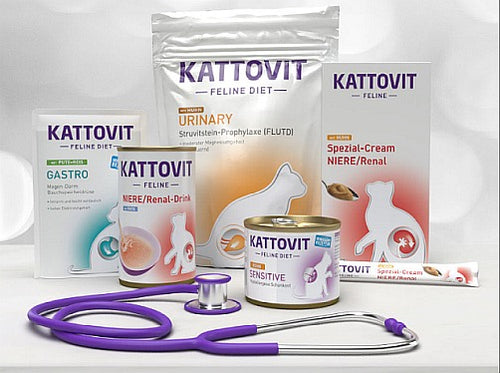The first sound that is associated with a cat is meowing. Cats have many other sounds in their repertoire. Even meowing occurs in different degrees and does not always mean the same thing. So what is your darling trying to tell you when it sits in front of your legs and loudly meows, purrs or even growls? In this guide, we will explain what cat sounds there are and what they mean. We will also give you tips on which sources of noise you should avoid so as not to frighten your furry friend, and show you sounds that cats react particularly positively to.
How Cats Communicate
While your cat is chatting happily with you and your family members, vocal communication with other cats seems to be very quiet. The reason for this is that cats rarely use vocal language to communicate with each other. They are more likely to communicate with each other using body language or smells . Loud screaming only occurs before or during a fight between two animals. So why can cats meow and make noises at all?
Meowing among other cats usually only occurs between the mother and her kittens . Since the little kittens still have their eyes closed shortly after birth, they are dependent on communicating using vocal language. After all, they cannot read their mother's body language. However, when they grow out of their childhood, both the kittens and the mother stop communicating with each other using vocal language. So if your cat meows at you, it is speaking to you in baby talk .
Your cat "talks" to you because it notices relatively quickly that you, as a human, cannot interpret all the physical and olfactory signals that your animal sends you. Therefore, the cat adapts to a type of verbal communication . Even if you and your cat speak a different language, you will notice that after a certain amount of time you can interpret individual sounds quite accurately.
[VitalCare1]
What sounds do cats make?
It's no secret that cats can meow. But the animals use a variety of sounds to show people what they want. Whether they're hungry, want to go outside or are making a threatening gesture: your pet has the right sound for every situation. Deaf animals also make sounds, and these are sometimes louder than those of cats with functioning hearing.
Meow
A soft, barely audible "meeeeee" or a long drawn-out "meow" can reflect a completely different need. However, the louder the meow, the more urgent the desire. Some meows are quite clear, for example when your house cat stands in front of its bowl and meows loudly. This is obviously a request for food . Meowing in front of a door in combination with scratching at it also clearly means: "Open the door for me." However, there are more than 60 different meow sounds . So what is your cat trying to tell you when it sits in the middle of the room and meows for no apparent reason?
This can actually vary from animal to animal. Often they want to get your attention and ask for caresses or they ask you to play . If your cat seeks contact with you, the meowing is usually accompanied by physical contact. They will then brush against your legs, for example, or, if they are particularly pushy, they will even stand next to you. However, some cats, such as Siamese cats, are just very talkative and chatter away. Feel free to respond with words as well, and you will notice that your darling is responding to you.
If your cat meows but no sound comes out, it may be hoarse . If other symptoms such as tiredness , lethargy or fever occur , your cat probably has a cold or flu. In this case, consult a veterinarian.
After a certain amount of time together, you will most likely learn what your cat is trying to tell you with a meow. Once you have adjusted to each other , communication will work better and you will be able to interpret your pet's meow correctly.
Purr
The purring of a cat sounds pleasant. If the animal is lying close to you or even on top of you, you will also notice light, pleasant vibrations . Purring not only calms your pet, but also you. The sound is even said to have a pain-relieving effect on people .
Cats can purr for long periods of time. They usually do this when they feel good, for example when they are being petted or when they are falling asleep. However, purring sounds do not always mean that your pet is doing well. Cats also purr to calm themselves down . If they are in pain , they try to relieve it with the sound.
How exactly cats purr has not yet been fully researched. On the one hand, it is assumed that the vocal cords vibrate when they breathe . On the other hand, the sound is said to come from the contraction of the larynx muscles and the diaphragm . Incidentally, not all cats can purr properly. Only domestic cats, pumas, cheetahs, lynxes and ocelots make this sound.
Hiss
Unlike purring, hissing is very clear: it means attention ! When a cat hisses, it feels threatened or is at least in a bad mood . So if your darling hisses at you, you should get away. No petting or other affection is desired here.
If there is no immediate danger to the animal and nothing else has happened that could explain the cat's aggressive behavior, you should take a closer look. Your furry friend may be ill or has Pain . Since cats tend to withdraw in such cases, they also react very negatively to their owners. If there are other If symptoms occur that do not match the cat's normal behavior, it is best to speak to a veterinarian.
howling and screaming
If cats make howling or screaming noises, something is wrong. Cats scream especially during a fight with another animal. The screaming can be quite loud . They meet each other and defend their territory, especially at night , when the animals are out on the prowl.
If your pet screams outside in a fight with another cat, this is usually no cause for concern. A few scratches may remain, but if your pet is vaccinated and regularly dewormed , contact with other cats should generally be safe. If the cat comes home after such a fight, you should still check if she is injured .
The howling sound of a cat sounds like a deep, drawn-out meow . If your cat howls, it wants to express its frustration . It may also be afraid or even in pain . The animal's posture in such situations signals defense. The pupils are usually quite large and the cat pulls all of its limbs very close to itself, so that it looks like a small package.
If your cat starts to howl, something is seriously wrong . Observe the animal and see if it has any injuries that could be causing pain. Also pay attention to its general behavior: is the cat aggressive , apathetic or seems listless ? Are there any other symptoms? Also check for external sources that could be frightening your house cat. Perhaps the music or the television is too loud or something else is frightening it.
humming and chattering
Before cats attack, they make a deep growl . This is a warning to the other person. If your cat growls and you ignore the warning, the animal may lash out with its claws or bite. Sometimes cats also make growling noises when they are afraid . So observe the situation carefully: does your animal feel threatened and want to warn you? Or could something be making it afraid?
Another sound that often astonishes non-cat owners is chattering . The cat makes a rapid "cook" sound while moving its jaw up and down. You will hear this especially when the animal is watching a bird or a fly . The cat appears to be completely focused . Why the animals display this behavior is not entirely clear. One theory is that by chattering their teeth, cats are imitating or practicing the neck bite with which they would actually kill the animal they are observing. Another theory sees chattering as bleating due to frustration. Because for the cat, it usually just observes.
Sounds that affect cats
Cats not only make a variety of noises, they also receive a large number of sounds themselves. Their hearing is much more sensitive than that of humans and also better than that of dogs, for example. While humans can perceive frequencies up to 20,000 hertz and dogs up to 40,000 hertz, cats can hear up to 65,000 hertz . The hearing of young cats is even better; they can hear frequencies up to 100,000 hertz.
If you watch your pet more closely, you will notice that its ears are constantly moving, sometimes even in opposite directions. This is because cats have 32 ear muscles that allow them to turn their ears 180 degrees , allowing them to localize and filter out ambient noise very precisely . The different rotational movements of their ears allow cats to even perceive two different sources of noise . This is particularly important when hunting.
Since animals can hear very well, it is important not to make the background noise in your home too loud . Loud and banging noises are pure stress for cats. They get scared and frightened. This is especially true of fireworks, sirens, loud music, the rustling of aluminum foil or thunderstorms . Loud household appliances such as hair dryers or food processors can also scare cats. Be particularly considerate here if the animal is not yet used to these noises. Also, avoid shouting at all costs , especially directly at your animal, as this can be very disturbing.
However, there are also sounds that are a treat for cats' ears . Since cats calm themselves down by purring, a purring sound from outside is also pleasant for them to hear. The sound produced when drinking milk also has a calming effect. There is therefore special cat music that combines such sounds. Studies show that the animals actually react positively to it and actively run towards the music boxes.









